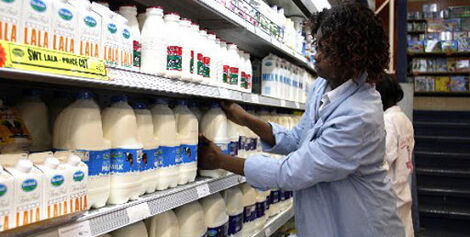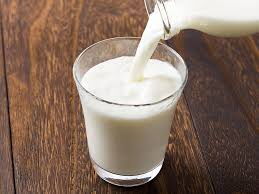The ongoing milk shortage will persist for at least another month.The Ministry of Agriculture is proposing a 30-day window for the importation of milk in order to address the crisis that has seen the price of the commodity spike.
The Ministry attributed the shortage to poor rains caused by continuous drought in most parts of the country. In addition, the ongoing drought has affected farmers as a recent National Food and Nutrition Security Report indicated that milk production in the country was at an all-time low.
Speaking to the media, the traders have also expressed fears that the situation could transition into a full-blown crisis with the ongoing fuel shortage which affects transportation, with as a section of matatu operators having withdrawn their vehicles from the road.
Various milk brands on the shelves of a Nairobi supermarket
Twitter
Further, the traders noted that a litre of milk can rise to an average of Ksh70 as opposed to the initial price of Ksh55. This has led to empty shelves in various supermarkets across the country.
“Previously we would remain with two boxes of milk after making sales the whole day. However, currently, due to the shortage, the boxes run out by 8 am as some consumers buy in bulk over the crisis,:”a trader stated.
Farmers have decried the high cost of animal feed, hence leading to inadequate milk production, seeking the government to heed to their plea.
Data from the Kenya National Bureau of Statistics revealed that the intake of milk in the formal sector increased to 802 million litres in 2021 as opposed to 684 million in 2020.
Currently, Kenyans have decried a rise in prices over various commodities, causing them to dig deeper into their pockets in order to acquire the said goods.
According to a recent KNBS report, prices of cooking oil, wheat flour white, and tomatoes increased by 6.50, 4.47, and 4.22 per cent in March 2022, respectively.
Further, furnishings, household equipment, and routine household equipment index, increased by 1.36 per cent between February 2022 and March 2022. This was due to an increase in prices of laundry/bar soap and detergents, among other items.
“The prices of most items increased significantly, in March compared to other previous months this year. This was mainly attributed to the increase in prices of most of the food items which outweighed the decrease in prices of others,” read part of the KNBS report.
Milk being poured from a jar to a glass.
Facebook

 Business News1 week ago
Business News1 week ago
 Business News2 days ago
Business News2 days ago
 Entertainment12 hours ago
Entertainment12 hours ago








